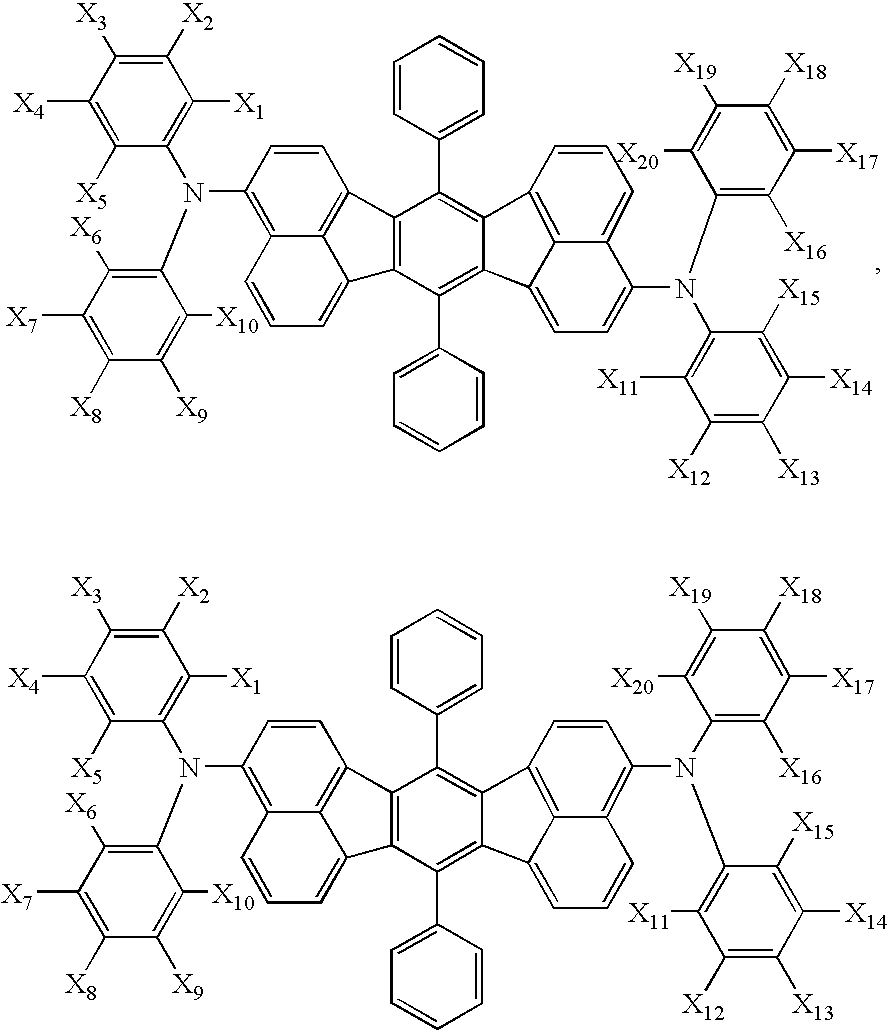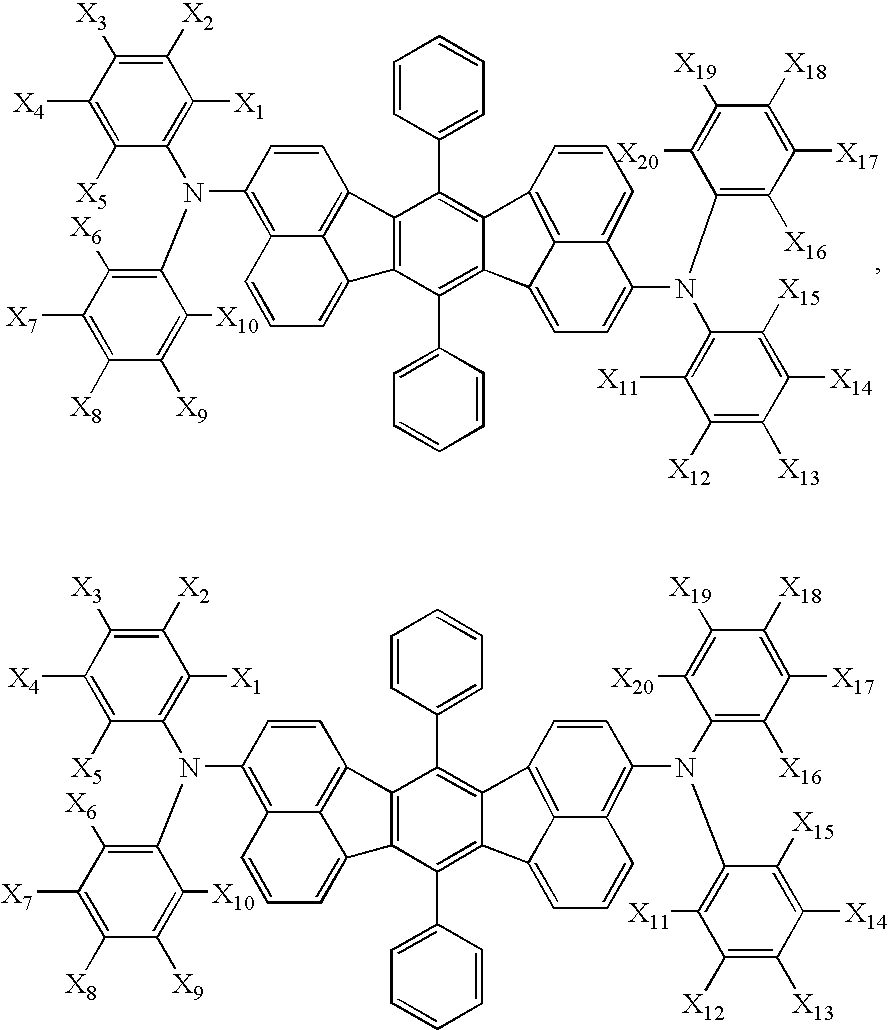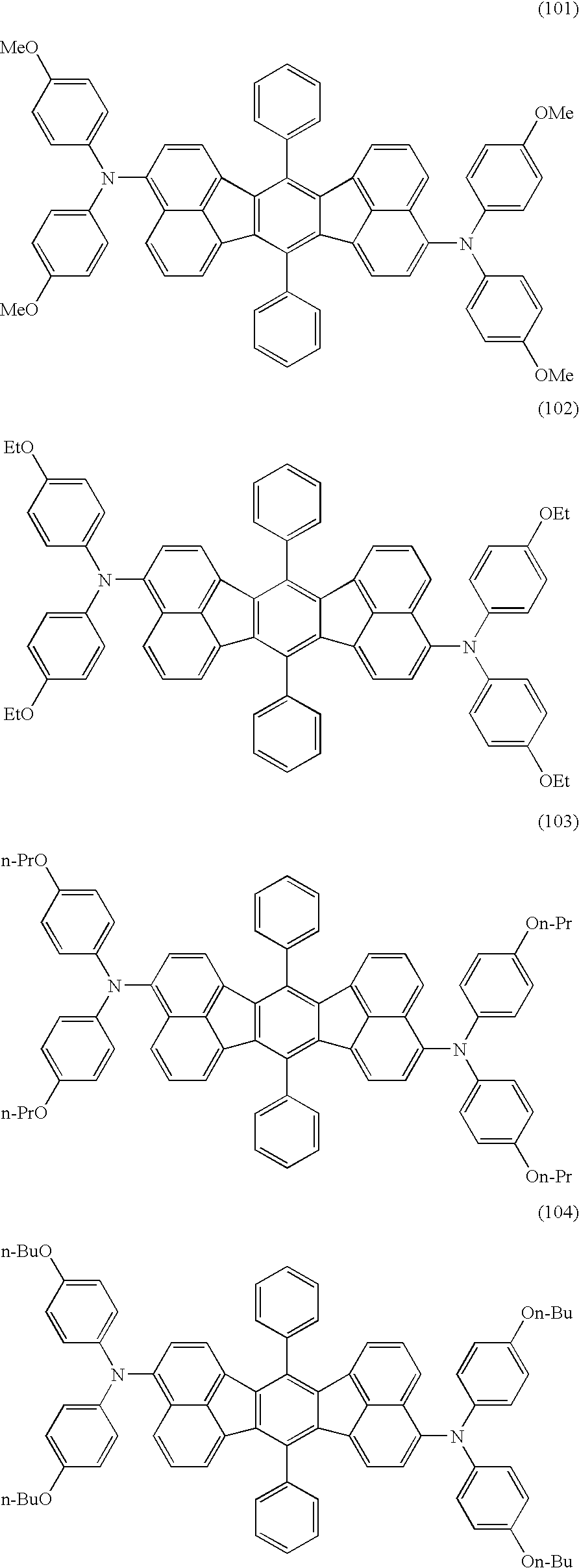Aromatic compounds and organic electroluminescent devices made by using the same
- Summary
- Abstract
- Description
- Claims
- Application Information
AI Technical Summary
Benefits of technology
Problems solved by technology
Method used
Image
Examples
preparation example 1
Synthesis of Compounds (101) and (101′)
[0044]The equation exhibiting the chemical reaction in the route of synthesis of Compounds (101) and (101′) is shown in the following.
[0045]
[0046]Into a 100 ml three-necked flask, 3.0 g (4.72 mmol) of a mixture of 3,10-dibromo-7,14-diphenylacenaphtho[1.2-k]fluoranthene and 3,11-dibromo-7,14-diphenylacenaphtho[1.2-k]fluoranthene (the ratio of the amounts: 7:3), 2.38 g (10.38 mmol) of 4,4′-dimethoxydiphenylamine, 64 mg (0.07 mmol) of tris(dibenzylideneacetone)dipalladium(0), 88 mg (0.14 mmol) of (S)-(−)-BINAP (2,2′-bis(diphenylphosphino)-1,1′-binaphthyl) and 1.1 g (11.4 mmol) of sodium t-butoxide were placed. After the flask was purged with argon, 50 ml of dehydrated toluene was added. The temperature of the resultant mixture was elevated to 110° C. under stirring, and the mixture was stirred further for 7 hours. After the reaction was completed, the reaction mixture was cooled to the room temperature, and 50 ml of dichloromethane was added. Afte...
preparation example 2
Synthesis of Compounds (108) and (108′)
[0049]The equation exhibiting the chemical reaction in the route of synthesis of Compounds (108) and (108′) is shown in the following.
[0050]
[0051]Into a 100 ml three-necked flask, 3.0 g (4.72 mmol) of a mixture of 3,10-dibromo-7,14-diphenylacenaphtho[1.2-k]fluoranthene and 3,11-dibromo-7,14-diphenylacenaphtho[1.2-k]fluoranthene (the ratio of the amounts: 9:1), 2.21 g (10.38 mmol) of (4-methoxyphenyl)-p-tolylamine, 64 mg (0.07 mmol) of tris(dibenzylideneacetone)dipalladium(0), 88 mg (0.14 mmol) of (S)-(−)-BINAP and 1.1 g (11.4 mmol) of sodium t-butoxide were placed. After the flask was purged with argon, 50 ml of toluene was added. The temperature of the resultant mixture was elevated to 110° C. under stirring, and the mixture was stirred further for 7 hours. After the reaction was completed, the reaction mixture was cooled to the room temperature, and 50 ml of dehydrated toluene was added. After being stirred at the room temperature for some ti...
preparation example 3
Synthesis of Compounds (504) and (504′)
[0054]The equation exhibiting the chemical reaction in the route of synthesis of Compounds (504) and (504′) is shown in the following.
[0055]
[0056]Into a 100 ml three-necked flask, 2.0 g (3.15 mmol) of a mixture of 3,10-dibromo-7,14-diphenylacenaphtho[1.2-k]fluoranthene and 3,11-dibromo-7,14-diphenylacenaphtho[1.2-k]fluoranthene (the ratio of the amounts: 8:2), 1.80 g (7.99 mmol) of (4-isopropylphenyl)-p-tolylamine, 44 mg (0.047 mmol) of tris(dibenzylideneacetone)dipalladium(0), 59 mg (0.095 mmol) of (S)-(−)-BINAP and 848 mg (8.82 mmol) of sodium t-butoxide were placed. After the flask was purged with argon, 50 ml of dehydrated toluene was added. The temperature of the resultant mixture was elevated to 115° C. under stirring, and the mixture was stirred further for 7.5 hours. After the reaction was completed, the reaction mixture was cooled to the room temperature, and 50 ml of dichloromethane was added. After being stirred at the room temperatu...
PUM
| Property | Measurement | Unit |
|---|---|---|
| Percent by mass | aaaaa | aaaaa |
| Weight | aaaaa | aaaaa |
| Purity | aaaaa | aaaaa |
Abstract
Description
Claims
Application Information
 Login to View More
Login to View More - R&D
- Intellectual Property
- Life Sciences
- Materials
- Tech Scout
- Unparalleled Data Quality
- Higher Quality Content
- 60% Fewer Hallucinations
Browse by: Latest US Patents, China's latest patents, Technical Efficacy Thesaurus, Application Domain, Technology Topic, Popular Technical Reports.
© 2025 PatSnap. All rights reserved.Legal|Privacy policy|Modern Slavery Act Transparency Statement|Sitemap|About US| Contact US: help@patsnap.com



